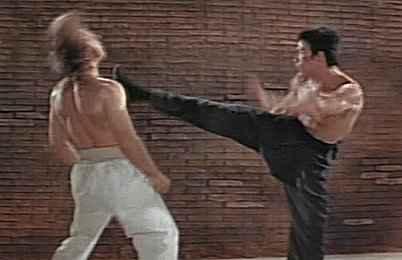|
Bruce Lee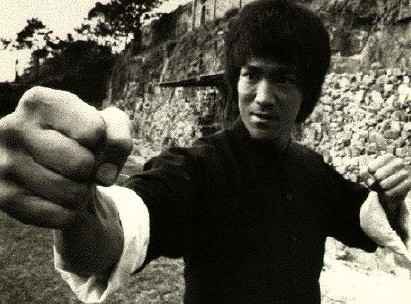 It's a sad, but true fact. You will never, ever, EVER be as cool as Bruce Lee.
It's a sad, but true fact. You will never, ever, EVER be as cool as Bruce Lee. It's not your fault. No one will ever be as cool as Bruce Lee. Hollywood star, philosopher, master martial artist, cinematographer, author... Bruce Lee was an unprecedented mix of serenity, poise, charisma and intellect, and an unstoppable ass-kicking virtuoso to boot. Time Magazine named Lee one of the 100 most influential people of the 20th century, putting him in the company of Albert Einstein, Martin Luther King and Adolf Hitler, among others. Bruce was born in 1940 in San Francisco's Chinatown. It was the Year of the Dragon in the Chinese zodiac, the start of a fateful theme in the young boy's life. His mother named him Lee Jun Fan, a girl's name, in order to confuse evil spirits that might otherwise kidnap him. Young Lee showed an immediate aptitude for film, convincingly playing a baby in 1941's Golden Gate Girl. OK, fine, babies don't technically show aptitude for anything. But it was the start of a trend nevertheless. The family moved to Hong Kong when Lee was three. He contined to appear as a child actor on Hong Kong's thriving movie scene, in such beloved classics as Er nu zhai, Ai xia ji, Qian wan ren jia, Wei lou chun xiao, Ci mu lei and who could forget Ku hai ming deng?
He began studying kung fu after getting into fights at school. Bruce quickly proved himself a prodigy, but his prowess didn't lessen the number of fights. Eventually, his family sent him back to the U.S. to keep him out of trouble. Bruce went to college in Seattle, where he studied philosophy and tutored students in the martial arts. Over the course of the next several years, his list of students would grow to include a fairly impressive list of celebrities and top martial arts talents, that would eventually include Chuck Norris, Steve McQueen, James Coburn, and Kareem Abdul-Jabbar. Lee dropped out of college, but not before meeting Linda Emery, whom he married just a year later. The Lees moved to California, where Bruce set up a kung fu school. Lee was challenged to a fight by a local martial arts master, who was offended by the fact that Bruce taught Westerners. Lee won the duel, but he decided the fight had taken too long, and began making notes on a new system of martial arts.
Lee's rising visibility led to interest from Hollywood. The producers of the campy Batman television show were looking to branch out with a series based on the radio adventures of The Green Hornet. Lee was hired to play the Hornet's chauffeur and sidekick Kato. Lee claimed he got the role because he was the only Asian actor to audition who could pronounce the name of the Hornet's secret identity "Britt Reid." The show was initially very popular, but began to flounder creatively when Lee's charisma as Kato vastly outstripped star Van Williams, whose portrayal of the Hornet was a stolid cross between Adam West's caped crusader and the equally humorless Lone Ranger (who was supposedly an ancestor of Britt Reid).
Lee wrote about the art and the philosophy of fighting while his back healed. Despite dropping out of college, he turned out to be a middling good philospher: "Truth has no path. Truth is living and, therefore, changing. Awareness is without choice, without demand, without anxiety; in that state of mind, there is perception. To know oneself is to study oneself in action with another person. Awareness has no frontier; it is giving of your whole being, without exclusion." Hard to argue with that. Hollywood's ardor had cooled by the time Bruce was ready to work again. He traveled to Hong Kong in 1970, where he met with producers in the thriving action film industry eager to cash in on The Green Hornet's popularity overseas.
Bruce adjusted his style for movies and TV work. Bruce had a keen intuitive sense about how fighting looked on the screen. Before his arrival on the scene, martial arts films were frequently of the "chop-socky" variety, featuring cheesy special effects and impossible gyrations, presented in a sloppy visual style. Lee choreographed his own fight scenes during all of his films, adding an awareness of the frame and motion of the camera that gave his fight sequences a balletic quality. As he gained more control over his films, he began to steer away from the superhuman feats typically featured in the kung fu genre, instead presenting a virtuoso fighting style that strained at the limits of the credible without quite breaking them. Lee followed Fists of Fury with The Chinese Connection, with a typical kung fu plot (avenging the death of a martial arts teacher) elevated by Lee's star presence and athletic skills, as well as a subplot dealing with racism.
During the same period, Lee shot footage for a film which would eventually be titled Game of Death, but he returned to the U.S. before shooting was finished. Wowed by Lee's international following, Hollywood had warmed up again. The 1972 release Enter the Dragon was arguably the only one of Lee's movies in which the word "masterpiece" did not have to be modified by the word "flawed." A joint production assembled between Hong Kong and Hollywood, the film was a lavish production compared to Lee's Hong Kong era, with a budget of $850,000, and big stars like... Well, John Saxon. (Remember, it was just comparatively lavish.) Enter the Dragon had everything Lee's previous films had lacked—namely, production values and a plot that was fairly coherent, if not exactly high art. Its release would have marked a new plateau of stardom for Lee, but he was fated to earn notoriety of a different sort. Just weeks before the movie's release, Bruce Lee died at age 32. The circumstances of his death are shrouded in mystery and innuendo. The official cause of death was a brain edema (swelling), but the cause of the disorder has never been satisfactorily resolved. The fact that Lee was found dead at the apartment of a mistress only added to the seamy and questionable nature of the scene.
Then again, it's possible that Bruce was just cursed, a theory which received a massive boost from the popular 1993 biopic Dragon: The Bruce Lee Story. Talk of a curse only deepened after the freakish death of Brandon Lee, Bruce's son with Linda, during shooting of the 1994 film, The Crow. Brandon Lee was killed when a stage prop gun loaded with blanks accidentally malfunctioned and lodged a wad of paper into his brain. He was 28. Bruce Lee's untimely death didn't mark the end of his cinematic adventures, however. Lee once said, "The key to immortality is first living a life worth remembering," and there's no danger of anyone forgetting his life any time soon.
Even after this atrocity, Bruce Lee was not allowed to rest in peace, not when there was money to be made. A series of "lookalikes" tried to keep Lee's legacy alive in the Hong Kong cinema with a series of mostly terrible knockoff movies starring such legendary martial artists as Bruce Le, Bruce Li, Bruce Lai, Bruce Thai, Bruce Lea and Dragon Lee. Bruce Li was the one who officially got the ball rolling, as the substitute in Game of Death. Typically, the films of these imitators didn't go far out of their way in advancing the craft of the original Bruce Lee. Most of them are centered around trying to establish themselves as legitimate successors to the Dragon's legacy, with titles like Goodbye Bruce Lee, Bruce's Fists of Vengeance, Bruce Is Loose, Bruce Lee's Ways of Kung Fu, The True Game of Death, The Fist of Fury, Fists of Bruce Lee, Image of Bruce Lee, Bruce Lee: The True Story, Re-enter the Dragon, Enter Three Dragons, Exit the Dragon Enter the Tiger, My Name Is Bruce, Return of Bruce, Bruce Li: Superdragon and Bruce Lee Fights Back from the Grave. In addition to the guys actually pretending to be Bruce Lee, there are even more guys who claim to have known Bruce Lee, and not just to have known them, but to have learned his ancient Chinese secrets. While some have embarked on more exotic careers (like Japanese pro-wrestler Ultimo Dragon, who didn't really study under Bruce), the vast majority of Bruce's "favorite students" now run their own martial arts dojos, with a substantial tuition markup on the basis of carrying on the Lee legacy, which was authoritatively passed along during the Dragon's life... "Then there was the time that I saw Bruce in the airport, and he was going to the other gate when I was at the snack bar, and he waved at me and..." Rumors have persisted for years that Bruce somehow faked his own death, like Jim Morrison and Elvis. If the funeral and autopsy weren't enough to convince you, then ask yourself this: Would the real Bruce Lee sit idly by somewhere while this mob of imitators and ass-kissers makes millions off his legacy? As the Dragon himself once said, "When the opportunity presents itself, I do not hit. It hits all by itself."
|
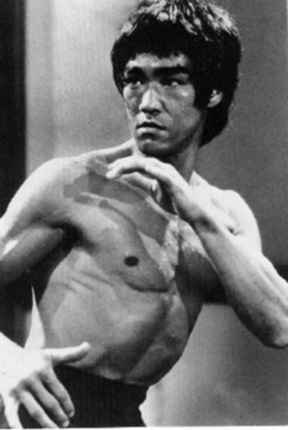 Like the proverbial boy named Sue, Bruce grew up tough. (Unlike the boy named Sue, he realized he didn't have to continue using a girl's name his whole life.)
Like the proverbial boy named Sue, Bruce grew up tough. (Unlike the boy named Sue, he realized he didn't have to continue using a girl's name his whole life.) 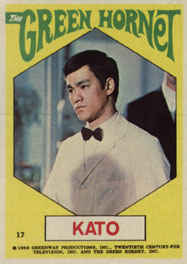 The duel brought Bruce a degree of local fame, but his participation in a national kung fu contest the same year marked the beginning of his national celebrity. Lee dominated a tournament in Long Beach, dispatching black belt Dan Insanto so quickly that Insanto asked to become his student.
The duel brought Bruce a degree of local fame, but his participation in a national kung fu contest the same year marked the beginning of his national celebrity. Lee dominated a tournament in Long Beach, dispatching black belt Dan Insanto so quickly that Insanto asked to become his student.  Just as his star was on the rise, however, Lee suffered a severe back injury that required months of rehabilitation. During his convalescence, Bruce refined his new style of martial arts, known as Jeet Kun Do, which means "Way of the Intercepting Fist." Jeet Kun Do was an innovative mix of fighting styles, integrating moves from dozens of other disciplines. Jeet Kun Do emphasized fluid movement and flowing with an opponent's strike.
Just as his star was on the rise, however, Lee suffered a severe back injury that required months of rehabilitation. During his convalescence, Bruce refined his new style of martial arts, known as Jeet Kun Do, which means "Way of the Intercepting Fist." Jeet Kun Do was an innovative mix of fighting styles, integrating moves from dozens of other disciplines. Jeet Kun Do emphasized fluid movement and flowing with an opponent's strike. 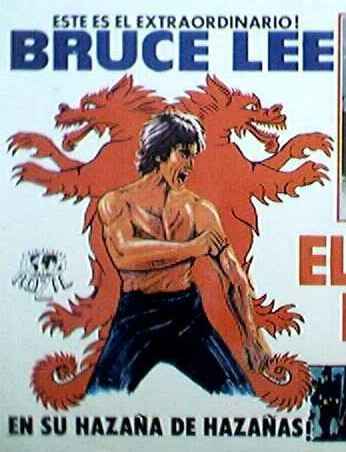 Lee had his first starring role in Fists of Fury, in which he takes on a local crime syndicate to protect his relatives. Made on a shoestring for less than $100,000, the film was bloody and fast-paced, and it was a big hit. Lee wrote the film and directed its fight sequences.
Lee had his first starring role in Fists of Fury, in which he takes on a local crime syndicate to protect his relatives. Made on a shoestring for less than $100,000, the film was bloody and fast-paced, and it was a big hit. Lee wrote the film and directed its fight sequences. 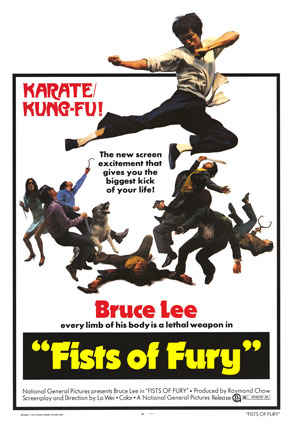 In 1972's Return of the Dragon, Lee again defended relatives against evil crimelords, but this time the action was set in Rome. In the movie, Bruce faces off against his real-life student, Chuck Norris, whose career as an action hero was launched by the film's dramatic climax, in which the two men battle for their lives in the Roman Colosseum.
In 1972's Return of the Dragon, Lee again defended relatives against evil crimelords, but this time the action was set in Rome. In the movie, Bruce faces off against his real-life student, Chuck Norris, whose career as an action hero was launched by the film's dramatic climax, in which the two men battle for their lives in the Roman Colosseum. 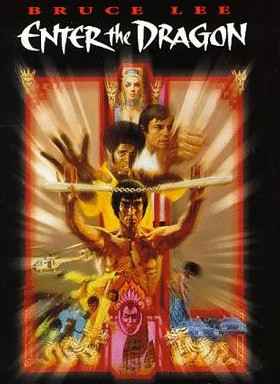 A long list of possible explanations for Lee's death have been floated by the conspiracy-minded, but there is no real evidence to support any one view. Some believe the edema was caused by a death blow by a martial arts rival, others suspected a drug overdose or poisoning.
A long list of possible explanations for Lee's death have been floated by the conspiracy-minded, but there is no real evidence to support any one view. Some believe the edema was caused by a death blow by a martial arts rival, others suspected a drug overdose or poisoning. 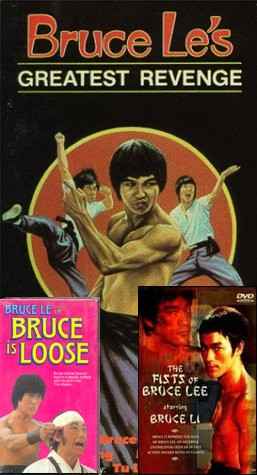 Desperate to eke a few more bucks out of the Bruce Lee money machine, producers cobbled together a nearly unwatchable cut of the unfinished Game of Death from surviving and stock footage, with an Ed Wood-style assist from a motorcycle-helmet wearing double for Bruce.
Desperate to eke a few more bucks out of the Bruce Lee money machine, producers cobbled together a nearly unwatchable cut of the unfinished Game of Death from surviving and stock footage, with an Ed Wood-style assist from a motorcycle-helmet wearing double for Bruce. 